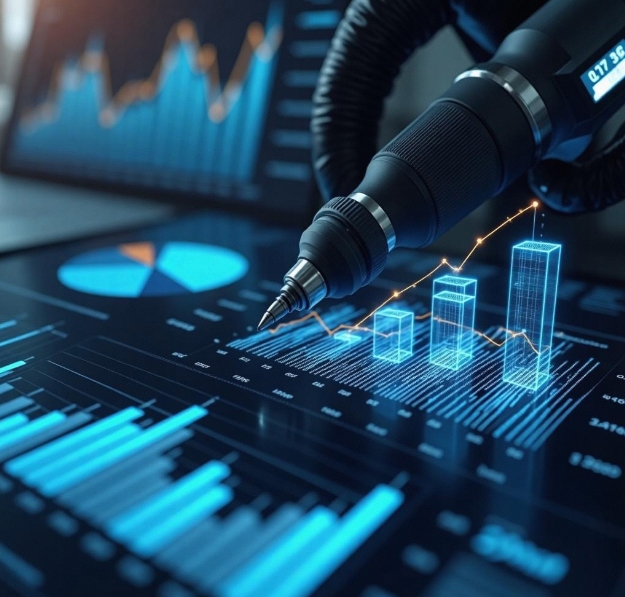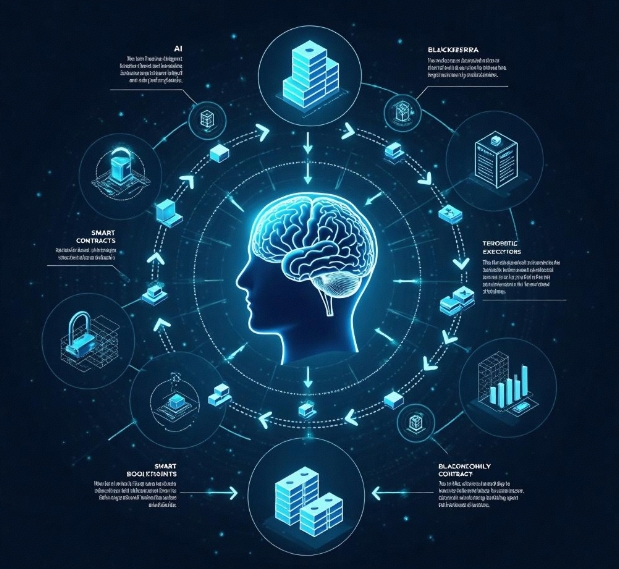The Integration of Artificial Intelligence and Blockchain: Enhancing Data Security and Transparency
- latest articles
- 1.DApp Development & Customization: Merging Diverse Market Needs with User Experience 2.Analysis of the Core Technical System in DApp Project Development 3.How to achieve cross-chain interoperability in Web3 projects? 4.How does the tokenization of points reconstruct the e-commerce ecosystem? 5.How to Set and Track Data Metrics for a Points Mall? 6.What is DApp Development? Core Concepts and Technical Analysis 7.Inventory of commonly used Web3 development tools and usage tips 8.Development of a Distribution System Integrated with Social E-commerce 9.Six Key Steps for Businesses to Build a Points Mall System 10.What is DApp Development? A Comprehensive Guide from Concept to Implementation
- Popular Articles
- 1.Future Trends and Technology Predictions for APP Development in 2025 2.Analysis of the DeFi Ecosystem: How Developers Can Participate in Decentralized Finance Innovation 3.From Zero to One: How PI Mall Revolutionizes the Traditional E-commerce Model 4.DAPP Development | Best Practices for Professional Customization and Rapid Launch 5.Recommended by the Web3 developer community: the most noteworthy forums and resources 6.From Cloud Computing to Computing Power Leasing: Building a Flexible and Scalable Computing Resource Platform 7.How to Develop a Successful Douyin Mini Program: Technical Architecture and Best Practices 8.Shared Bike System APP: The Convenient Choice in the Era of Smart Travel 9.How to Create a Successful Dating App: From Needs Analysis to User Experience Design 10.From Design to Development: The Complete Process of Bringing an APP Idea to Life
With the rapid advancement of technology, artificial intelligence (AI) and blockchain have become the most prominent and explored cutting-edge technologies today. Each offers significant advantages in areas such as data processing and security, decentralization, and intelligent decision-making. Combining them can bring profound impacts across various industries. Particularly in enhancing data security and transparency, the integration of AI and blockchain provides more efficient and trustworthy solutions. This article will explore the benefits, practical applications, and future trends of combining these two technologies.
I. Basic Concepts of Artificial Intelligence and Blockchain
1.1 Introduction to Artificial Intelligence
Artificial Intelligence (AI) refers to the simulation of human cognitive abilities to perform tasks that require intelligence, such as learning, reasoning, understanding, and decision-making. It typically operates through algorithms and big data analysis. With advancements in computing power and machine learning, AI can now handle more complex tasks and demonstrates significant potential in fields like healthcare, finance, and education.
1.2 Introduction to Blockchain
Blockchain is a distributed ledger technology characterized by decentralization, immutability, and transparency. By distributing data across multiple nodes, blockchain ensures data security and tamper resistance. Each data record (i.e., a "block") is cryptographically linked to the previous one, forming a chain. Due to its decentralized nature, blockchain technology is widely used in digital currencies, smart contracts, and supply chain management.
II. The Integration of Artificial Intelligence and Blockchain
2.1 The Complementarity of AI and Blockchain
The core of AI is data. AI algorithms require extensive training on large datasets to make accurate predictions and decisions. However, data security, reliability, and transparency pose significant challenges in many applications. Particularly in fields like finance and healthcare, data breaches, tampering, and privacy issues can lead to substantial risks.
Blockchain technology, with its decentralized and immutable characteristics, provides a secure and trustworthy environment for data storage and transmission. By recording AI-generated data, algorithm models, and decision-making processes on the blockchain, the immutability of this data is ensured, preventing leaks and misuse. Additionally, blockchain's transparency allows all participants to monitor data usage in real-time, ensuring fairness and transparency.
2.2 Enhancing Data Security
The application of AI technology relies on large amounts of high-quality data, which often includes users' private information. Traditional data storage methods are vulnerable to hacking, data tampering, or leaks. Blockchain technology, due to its decentralized nature, effectively mitigates the risks of single points of failure and data tampering.
In an architecture combining AI and blockchain, data can be encrypted and stored on the blockchain to ensure its security. Moreover, data access permissions and usage can be automatically managed through smart contracts, further enhancing data security. For example, in healthcare, patients' health data can be stored on the blockchain, accessible only to authorized doctors and hospitals, eliminating concerns about data tampering or misuse.
2.3 Improving Data Transparency and Traceability
Blockchain's transparency enables all parties to view the data flow process on a unified platform, which is crucial for ensuring data fairness and transparency. The training process of AI models can also be recorded on the blockchain, making every step traceable. This is significant for enhancing the credibility of AI algorithms and reducing algorithmic bias.
For instance, in financial risk control, the decision-making process behind AI is often a complex black-box model. However, by recording the model training process, data sources, and processing steps on the blockchain, anyone can trace the model's inputs, outputs, and evolution, ensuring transparency and fairness while avoiding human manipulation and bias.
III. Application Scenarios of AI and Blockchain Integration
3.1 Financial Sector
In the financial sector, the combination of blockchain and AI can enhance data transparency, optimize risk control models, and ensure transaction security. Blockchain ensures the authenticity and security of transactions, while AI enables intelligent analysis and predictive modeling for risk assessment and market forecasting. For example, in loan approval processes, AI can analyze a borrower's credit history, spending behavior, and other data to assess risk, with blockchain recording each approval step to prevent data tampering.
Additionally, smart contracts are a key application of blockchain and AI integration in finance. Smart contracts can automatically execute predefined conditions and terms, reducing manual intervention and improving the efficiency and security of financial transactions.
3.2 Healthcare Sector
In healthcare, the integration of AI and blockchain can effectively address patient data privacy issues. Medical data often contains sensitive information, and traditional medical record systems are susceptible to hacking or data breaches. Through blockchain technology, medical data can be encrypted and stored, with access restricted to authorized doctors and patients, mitigating the risk of data leaks.
AI applications in healthcare are increasingly widespread, from disease prediction and image recognition to personalized treatment plans. When combined with blockchain, medical data becomes more transparent and trustworthy, aiding doctors and patients in making more accurate decisions.
3.3 Supply Chain Management
In supply chain management, blockchain can record the flow path of each product, ensuring authenticity and quality. Meanwhile, AI can optimize inventory management and predict demand fluctuations through data analysis and forecasting. By integrating blockchain and AI, supply chain management achieves data transparency while improving efficiency and reducing waste and losses through AI algorithms.
For example, in the food industry, blockchain can track every step from farm to table, ensuring food quality and safety. AI can analyze this data to predict potential supply chain risks, helping businesses prepare in advance.
IV. Challenges and Future Development of AI and Blockchain Integration
Despite the immense potential of combining AI and blockchain, several challenges remain in practical applications. First, blockchain's performance issues, particularly its relatively slow processing speed when handling large-scale data, remain a bottleneck for widespread adoption. Since AI requires substantial data support, efficiently storing and processing data on the blockchain is an urgent problem to solve.
Second, regulatory issues surrounding blockchain technology are also challenging. While blockchain offers decentralized solutions, its anonymity and immutability complicate regulation. For instance, in cross-border transactions, ensuring blockchain platforms comply with different countries' laws and regulations is a problem that needs addressing.
However, as technology continues to evolve, the integration of AI and blockchain will become more mature. In the future, with improvements in blockchain performance, optimization of AI algorithms, and the refinement of relevant regulations, the combination of AI and blockchain will drive innovation and transformation across various industries.
Conclusion
The integration of artificial intelligence and blockchain technology not only enhances data security and transparency but also promotes digital transformation across industries. Although technical challenges and application difficulties persist, continuous innovation and refinement promise a bright future for AI and blockchain integration. In the years to come, AI and blockchain will create a smarter, more transparent, and secure digital world.
-

How does artificial intelligence technology transform the operational models of modern enterprises?
In the wave of the digital era, artificial intelligence (AI) technology has tran···
-

How to Utilize Artificial Intelligence for Precision Medicine and Health Management
With the rapid advancement of technology, artificial intelligence (AI) has demon···
-

Integration and Application of Artificial Intelligence and Robotics
In today's era of rapid technological advancement, the integration of artificial···

 Blockchain
Blockchain












